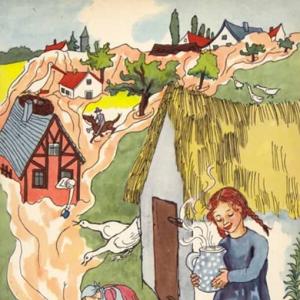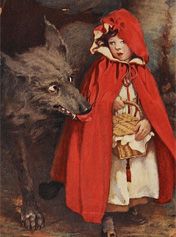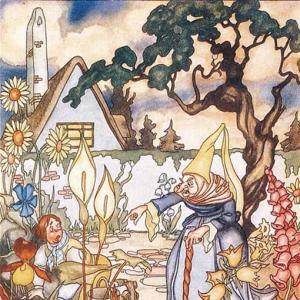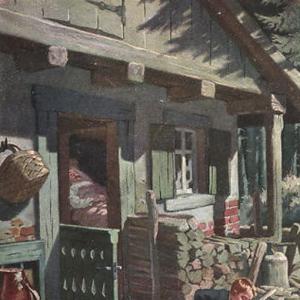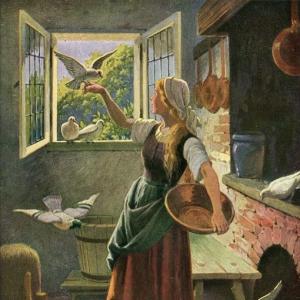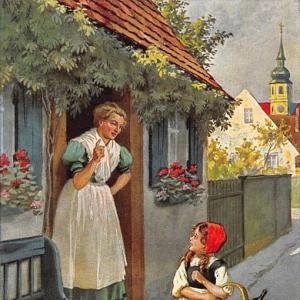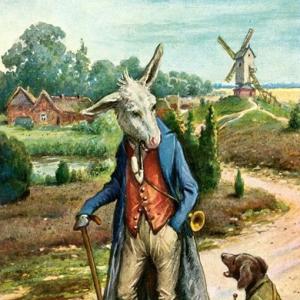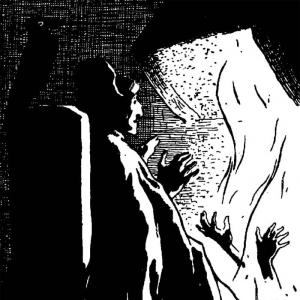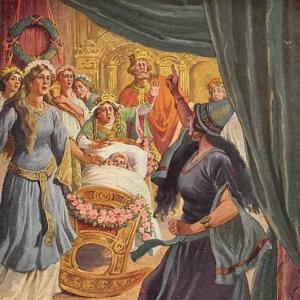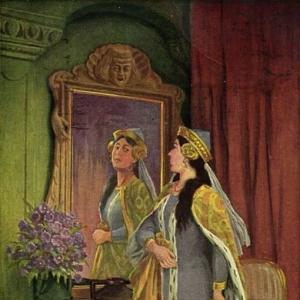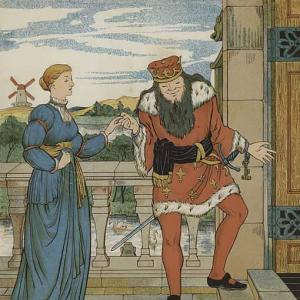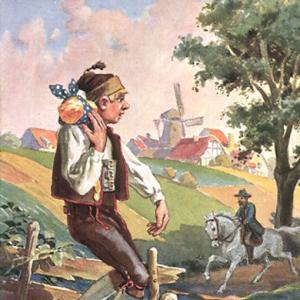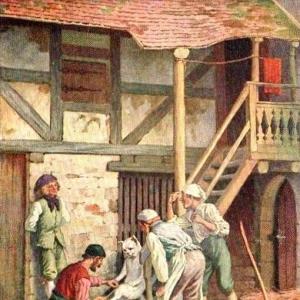Reading time for children: 8 min
Once upon a time there was a man who did nothing but gamble, and for that reason people never called him anything but Gambling Hansel, and as he never ceased to gamble, he played away his house and all that he had. Now the very day before his creditors were to take his house from him, came the Lord and St. Peter, and asked him to give them shelter for the night. Then Gambling Hansel said, „For my part, you may stay the night, but I cannot give you a bed or anything to eat.“ So the Lord said he was just to take them in, and they themselves would buy something to eat, to which Gambling Hansel made no objection. Thereupon St. Peter gave him three groschen, and said he was to go to the baker’s and fetch some bread. So Gambling Hansel went, but when he reached the house where the other gambling vagabonds were gathered together, they, although they had won all that he had, greeted him clamorously, and said, „Hansel, do come in.“ – „Oh,“ said he, „do you want to win the three groschen too?“ On this they would not let him go. So he went in, and played away the three groschen also. Meanwhile St. Peter and the Lord were waiting, and as he was so long in coming, they set out to meet him.
When Gambling Hansel came, however, he pretended that the money had fallen into the gutter, and kept raking about in it all the while to find it, but our Lord already knew that he had lost it in play. St. Peter again gave him three groschen, and now he did not allow himself to be led away once more, but fetched them the loaf. Our Lord then inquired if he had no wine, and he said, „Alack, sir, the casks are all empty!“ But the Lord said he was to go down into the cellar, for the best wine was still there. For a long time he would not believe this, but at length he said, „Well, I will go down, but I know that there is none there.“ When he turned the tap, however, lo and behold, the best of wine ran out! So he took it to them, and the two passed the night there. Early next day our Lord told Gambling Hansel that he might beg three favours. The Lord expected that he would ask to go to Heaven; but Gambling Hansel asked for a pack of cards with which he could win everything, for dice with which he would win everything, and for a tree whereon every kind of fruit would grow, and from which no one who had climbed up, could descend until he bade him do so. The Lord gave him all that he had asked, and departed with St. Peter.
And now Gambling Hansel at once set about gambling in real earnest, and before long he had gained half the world. Upon this St. Peter said to the Lord, „Lord, this thing must not go on, he will win, and thou lose, the whole world. We must send Death to him.“ When Death appeared, Gambling Hansel had just seated himself at the gaming-table, and Death said, „Hansel, come out a while.“ But Gambling Hansel said, „Just wait a little until the game is done, and in the meantime get up into that tree out there, and gather a little fruit that we may have something to munch on our way.“ Thereupon Death climbed up, but when he wanted to come down again, he could not, and Gambling Hansel left him up there for seven years, during which time no one died.
So St. Peter said to the Lord, „Lord, this thing must not go on. People no longer die. We must go ourselves.“ And they went themselves, and the Lord commanded Hansel to let Death come down. So Hansel went at once to Death and said to him, „Come down,“ and Death took him directly and put an end to him. They went away together and came to the next world, and then Gambling Hansel made straight for the door of Heaven, and knocked at it. „Who is there?“ – „Gambling Hansel.“ – „Ah, we will have nothing to do with him! Begone!“ So he went to the door of Purgatory, and knocked once more. „Who is there?“ – „Gambling Hansel.“ – „Ah, there is quite enough weeping and wailing here without him. We do not want to gamble, just go away again.“ Then he went to the door of Hell, and there they let him in.
There was, however, no one at home but old Lucifer and the crooked devils who had just been doing their evil work in the world. And no sooner was Hansel there than he sat down to gamble again. Lucifer, however, had nothing to lose, but his mis-shapen devils, and Gambling Hansel won them from him, as with his cards he could not fail to do. And now he was off again with his crooked devils, and they went to Hohenfuert and pulled up a hop-pole, and with it went to Heaven and began to thrust the pole against it, and Heaven began to crack. So again St. Peter said, „Lord, this thing cannot go on, we must let him in, or he will throw us down from Heaven.“ And they let him in. But Gambling Hansel instantly began to play again, and there was such a noise and confusion that there was no hearing what they themselves were saying. Therefore St. Peter once more said, „Lord, this cannot go on, we must throw him down, or he will make all Heaven rebellious.“ So they went to him at once, and threw him down, and his soul broke into fragments, and went into the gambling vagabonds who are living this very day.
 Learn languages. Double-tap on a word.Learn languages in context with Childstories.org and Deepl.com.
Learn languages. Double-tap on a word.Learn languages in context with Childstories.org and Deepl.com.Backgrounds
Interpretations
Adaptions
Summary
Linguistics
„Gambling Hansel“ is a lesser-known fairy tale collected by the Brothers Grimm, Jacob and Wilhelm Grimm, who were German academics, linguists, and authors. They were prominent figures in the 19th-century European folklore movement and are best known for their collection of fairy tales titled „Kinder- und Hausmärchen“ (Children’s and Household Tales), first published in 1812. The collection went through multiple editions and revisions, with the seventh and final edition being published in 1857.
The Brothers Grimm aimed to preserve traditional stories that were primarily passed down orally, collecting them from various sources, including friends, family, and written works. Their collection of fairy tales includes stories with origins in different European cultures and time periods, ranging from ancient myths to contemporary legends. The tales were often rewritten and adapted by the Grimms to reflect the values and sensibilities of their time.
„Gambling Hansel“ is an example of a fairy tale that incorporates themes of morality, divine intervention, and the consequences of one’s actions. It reflects the cultural and social values of its time, with an emphasis on the importance of self-control, resisting temptation, and seeking redemption. The tale also showcases the Brothers Grimm’s interest in exploring the darker aspects of human nature, which is a recurring theme throughout their collection of fairy tales.
„Gambling Hansel“ offers several interpretations and moral lessons:
The dangers of addiction: The story highlights the negative consequences of gambling addiction, as Hansel loses everything he has, including his chance for redemption in the afterlife. His constant desire for gambling leads to chaos and destruction, emphasizing the importance of moderation and self-control.
The power of temptation: The tale serves as a cautionary message about the power of temptation and the importance of resisting it. Hansel’s inability to resist gambling leads him down a destructive path, affecting not only himself but also those around him.
The consequences of selfishness: Hansel’s wishes are focused on his own personal gain rather than the well-being of others. This selfishness leads to suffering for both himself and others, suggesting that selflessness and concern for others are important virtues.
The importance of redemption and forgiveness: The story illustrates the potential for redemption and forgiveness, even for those who have made grave mistakes. When Hansel is finally allowed into Heaven, it shows that people can change and find forgiveness if given the chance. However, Hansel’s inability to change his ways ultimately leads to his downfall.
The role of divine intervention: Throughout the story, the Lord and St. Peter repeatedly attempt to guide Hansel towards a better path. This can be interpreted as a reminder that there is a higher power watching over humanity and trying to help people make the right choices.
In summary, „Gambling Hansel“ serves as a cautionary tale about the dangers of addiction, temptation, and selfishness, while also highlighting the importance of redemption, forgiveness, and divine guidance.
The fairy tale „Gambling Hansel“ from Brothers Grimm has been adapted into various forms over the years, including:
Children’s books: Several children’s books have been published based on the story of „Gambling Hansel.“ These books often simplify the original tale and include colorful illustrations.
Plays and musicals: „Gambling Hansel“ has also been adapted into plays and musicals for both children and adults. These adaptations often add new characters or subplots to the original story.
Animated films: The story has been adapted into several animated films, including a Soviet film titled „Hans in Luck“ and a German film titled „Hans im Glück.“
Video games: „Gambling Hansel“ has been adapted into several video games, including a mobile game titled „Hans in Luck“ and a PC game titled „Lucky Hans.“
Variations in other media: The story has been adapted and referenced in various other media, such as in the novel „American Gods“ by Neil Gaiman, where the character Shadow tells a version of the story to a child.
Overall, „Gambling Hansel“ has been adapted into various forms of media and has remained a popular tale for children and adults alike.
„Gambling Hansel“ is a fairy tale by the Brothers Grimm that tells the story of a man known as Gambling Hansel, who loses everything he has to gambling. One day, the Lord and St. Peter seek shelter at his house, and despite having nothing to offer them, they stay the night. St. Peter gives Hansel money to buy bread, but he gambles it away. Eventually, Hansel fetches bread and wine, and the Lord grants him three wishes. Instead of asking for salvation, Hansel wishes for a magical pack of cards, enchanted dice, and a tree that traps anyone who climbs it until he allows them to descend.
With these items, Hansel gambles and wins half the world. To stop him, the Lord sends Death, but Hansel tricks Death into climbing the tree and traps him for seven years, during which no one dies. The Lord and St. Peter then force Hansel to release Death, who promptly kills him. In the afterlife, Hansel is denied entry to Heaven and Purgatory, so he enters Hell and gambles with Lucifer. He wins all the crooked devils and uses them to threaten Heaven.
St. Peter and the Lord finally let Hansel into Heaven, but his gambling causes chaos. They decide to throw him out, and his soul shatters into fragments, entering the bodies of gambling vagabonds who continue to exist in the world.
The fairy tale „Gambling Hansel“ by the Brothers Grimm is a story rich with symbolic and thematic elements typical of traditional European folklore. Here is a linguistic analysis of the tale, focusing on its narrative structure, use of language, and underlying motifs:
Narrative Structure
Exposition: The story begins with the introduction of Gambling Hansel, a man whose identity is intrinsically tied to his vice: gambling. The introduction sets the stage for Hansel’s financial ruin, as he has lost everything to gambling.
Inciting Incident: The arrival of the Lord and St. Peter seeking shelter marks the beginning of Hansel’s encounters with the divine, which catalyzes the subsequent events of the story.
Rising Action: Hansel’s repeated failures to provide for his guests due to his gambling addiction highlight his inability to change his ways. His requests for magical objects from the Lord signify his desire to exploit divine generosity for personal gain.
Climax: The pinnacle of the story is reached when Hansel’s manipulation extends beyond mortality itself, as he traps Death, causing chaos in the world.
Falling Action: The resolution of the situation involves divine intervention, as the Lord and St. Peter must personally address the chaos Hansel has caused.
Conclusion: The story concludes with Hansel’s rejection from Heaven, Purgatory, and his eventual acceptance into Hell. Even then, Hansel continues his gambling ways, disturbing the order of the afterlife until he is finally cast out.
Use of Language
Repetition: The repetitive structure of Hansel’s gambling losses emphasizes his compulsive nature. Phrases related to gambling and loss („played away,“ „won all that he had“) are recurrent, underscoring his addiction.
Dialogue: The dialogue between characters, particularly Hansel’s interactions with the divine, highlights the contrast between human folly and divine patience. The repetition of „Who is there? – ‚Gambling Hansel. ‚“ at the gates of the afterlife adds a ritualistic, almost liturgical rhythm to the narrative.
Symbolism: Key symbols include the magical cards and dice, representing luck and fate, and the fruit tree, symbolizing temptation and entrapment. These elements serve as physical manifestations of Hansel’s desires and cunning.
Underlying Motifs
Gambling as a Vice: Gambling serves as a metaphor for human weakness and moral corruption. Hansel’s inability to resist gambling illustrates the destructive nature of unchecked desire.
Divine Justice: The presence of the Lord and St. Peter introduces themes of divine justice and morality. Despite Hansel’s transgressions, the divine figures offer opportunities for redemption, reflecting themes of mercy and punishment.
Mortality and Immortality: The theme of mortality is explored through Hansel’s interaction with Death. By imprisoning Death, Hansel disrupts the natural order, highlighting the consequences of human hubris in attempting to transcend mortal limits.
Rejection and Redemption: The tale explores themes of rejection and redemption, as Hansel is denied entry into Heaven and Purgatory due to his actions, ultimately facing consequences in a cyclic and ironic manner.
Overall, „Gambling Hansel“ employs traditional narrative techniques and linguistic devices to weave a cautionary tale about the perils of vice, the limits of human cunning, and the ultimate supremacy of divine justice.
Information for scientific analysis
Fairy tale statistics | Value |
|---|---|
| Number | KHM 82 |
| Aarne-Thompson-Uther-Index | ATU Typ 330A |
| Translations | DE, EN, DA, ES, PT, IT, JA, NL, PL, RU, TR, VI, ZH |
| Readability Index by Björnsson | 26 |
| Flesch-Reading-Ease Index | 84.5 |
| Flesch–Kincaid Grade-Level | 5.5 |
| Gunning Fog Index | 7.9 |
| Coleman–Liau Index | 7.5 |
| SMOG Index | 7.6 |
| Automated Readability Index | 5.4 |
| Character Count | 5.098 |
| Letter Count | 3.893 |
| Sentence Count | 60 |
| Word Count | 984 |
| Average Words per Sentence | 16,40 |
| Words with more than 6 letters | 94 |
| Percentage of long words | 9.6% |
| Number of Syllables | 1.229 |
| Average Syllables per Word | 1,25 |
| Words with three Syllables | 35 |
| Percentage Words with three Syllables | 3.6% |

